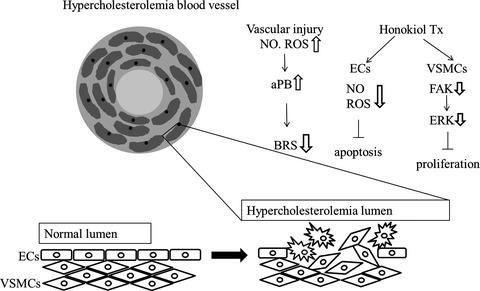当前位置:
X-MOL 学术
›
Food Sci. Nutr.
›
论文详情
Our official English website, www.x-mol.net, welcomes your
feedback! (Note: you will need to create a separate account there.)
Honokiol, an active compound of Magnolia officinalis, is involved in restoring normal baroreflex sensitivity in hypercholesterolemic rabbits
Food Science & Nutrition ( IF 3.5 ) Pub Date : 2020-01-14 , DOI: 10.1002/fsn3.1395 Pei‐Yu Chou, Weng‐Cheng Chang, Fon‐Chang Liu, Shou‐Jen Lan, Ming‐Jyh Sheu, Jwo‐Sheng Chen
Food Science & Nutrition ( IF 3.5 ) Pub Date : 2020-01-14 , DOI: 10.1002/fsn3.1395 Pei‐Yu Chou, Weng‐Cheng Chang, Fon‐Chang Liu, Shou‐Jen Lan, Ming‐Jyh Sheu, Jwo‐Sheng Chen

|
This study investigated the effects of methanol extract Magnolia officinalis (MEMO) on baroreceptor reflex sensitivity (BRS) in the hypercholesterolemic rabbits and the involved molecular mechanisms. Male New Zealand white rabbits were randomly divided into Control (normal diet), Cholesterol (0.5% w/w cholesterol diet), and Magnolia groups (0.5% w/w cholesterol diet plus 1% w/w MEMO). The animals were treated with the designated diet for 4 or 8 weeks. BRS in the control of heart rate was assessed by linear regression method. After 8 weeks of treatments, plasma total cholesterol (TC) was significantly elevated in the Cholesterol/Magnolia groups. The arterial blood pressure (aBP) was increased in the Cholesterol and Magnolia groups. The depression of BRS observed in the Cholesterol group was significantly ameliorated in the Magnolia group. After L‐NAME (Nω‐nitro‐Larginine methyl ester, 20 mg/kg, iv), the BRS of the Cholesterol group was significantly improved. Results from our in vitro study further indicated that honokiol, the principle component of MEMO, would protect human umbilical vein endothelial cells (HUVECs) from H2O2‐induced damages and inhibit H2O2‐induced vascular smooth muscles cells (VSMCs) proliferation, which was evident by the decreased expression of pFAK, and p‐Erk1/2. The results of the present study suggested that the improvement of BRS by MEMO in the hypercholesterolemic rabbits might be mediated by the antioxidant property of MEMO as indicated by the results from the L‐NAME and in vitro honokiol studies.
中文翻译:

和厚朴酚是厚朴的一种活性化合物,参与恢复高胆固醇血症兔的正常压力反射敏感性
本研究探讨厚朴甲醇提取物(MEMO)对高胆固醇血症家兔压力感受器反射敏感性(BRS)的影响及其分子机制。雄性新西兰白兔被随机分为对照组(正常饮食)、胆固醇组(0.5% w/w 胆固醇饮食)和木兰组(0.5% w/w 胆固醇饮食加 1% w/w MEMO)。动物接受指定饮食治疗 4 或 8 周。通过线性回归方法评估BRS对心率的控制。治疗 8 周后,胆固醇/木兰组的血浆总胆固醇 (TC) 显着升高。胆固醇组和木兰组的动脉血压(aBP)升高。胆固醇组中观察到的 BRS 抑制在木兰组中显着改善。 L-NAME( Nω-硝基-精氨酸甲酯,20 mg/kg,静脉注射)后,胆固醇组的 BRS 显着改善。我们的体外研究结果进一步表明,MEMO 的主要成分和厚朴酚可以保护人脐静脉内皮细胞 (HUVEC) 免受 H 2 O 2诱导的损伤,并抑制 H 2 O 2诱导的血管平滑肌细胞 (VSMC)增殖,这通过 pFAK 和 p-Erk1/2 表达的减少来证明。本研究的结果表明,MEMO 对高胆固醇血症兔的 BRS 的改善可能是由 MEMO 的抗氧化特性介导的,如 L-NAME 和体外和厚朴酚研究的结果所示。
更新日期:2020-01-14
中文翻译:

和厚朴酚是厚朴的一种活性化合物,参与恢复高胆固醇血症兔的正常压力反射敏感性
本研究探讨厚朴甲醇提取物(MEMO)对高胆固醇血症家兔压力感受器反射敏感性(BRS)的影响及其分子机制。雄性新西兰白兔被随机分为对照组(正常饮食)、胆固醇组(0.5% w/w 胆固醇饮食)和木兰组(0.5% w/w 胆固醇饮食加 1% w/w MEMO)。动物接受指定饮食治疗 4 或 8 周。通过线性回归方法评估BRS对心率的控制。治疗 8 周后,胆固醇/木兰组的血浆总胆固醇 (TC) 显着升高。胆固醇组和木兰组的动脉血压(aBP)升高。胆固醇组中观察到的 BRS 抑制在木兰组中显着改善。 L-NAME( Nω-硝基-精氨酸甲酯,20 mg/kg,静脉注射)后,胆固醇组的 BRS 显着改善。我们的体外研究结果进一步表明,MEMO 的主要成分和厚朴酚可以保护人脐静脉内皮细胞 (HUVEC) 免受 H 2 O 2诱导的损伤,并抑制 H 2 O 2诱导的血管平滑肌细胞 (VSMC)增殖,这通过 pFAK 和 p-Erk1/2 表达的减少来证明。本研究的结果表明,MEMO 对高胆固醇血症兔的 BRS 的改善可能是由 MEMO 的抗氧化特性介导的,如 L-NAME 和体外和厚朴酚研究的结果所示。











































 京公网安备 11010802027423号
京公网安备 11010802027423号